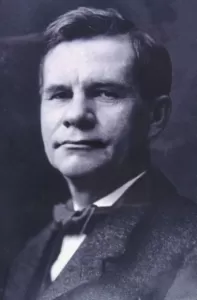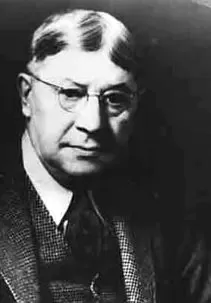Craftsman Associated Cabinetmakers: A Stickley Reunion
by Kate Nixon


Above: Gustav Stickley and Leopold Stickley, brothers and business partners
Among Gustav Stickley’s many versions of his Craftsman ventures, one of the more short-lived and lesser known attempts in the later years of his time as a business man was the Stickley Associated Cabinetmakers, a venture that united Gustav with his brothers and their respective companies. The reunion came about out of turbulent times for Stickley, for in 1916 he resigned from the Craftsman Publishing Company, his utopian Craftsman Farms was in financial jeopardy, and his presence in New York City’s Craftsman Building reduced to the second and third story where his shop was.

The shopmark for Stickley Associated Cabinetmakers, Gustav Stickley’s brief Craftsman venture in partnership with his brothers Leopold and John George. The shopmark, showing a combination of red tools, was used from 1918 – 1920.
Gustav attempted to revive his success by developing a new line of furniture with color applied to the furniture named “Chromewald” – unfortunately this marked the beginning of a difficult chapter in Gustav’s book. Needless to say, Chromewald did not replicate the success of his earlier furniture lines and with the very public failures of his businesses and withdrawing from The Craftsman publication, Gustav found himself in dire straights both financially and mentally. His own family gave him a brief respite.
In December 2016, out of desperation to keep his Craftsman business afloat and get out of financial quicksand, Gustav along with his brothers formed the company named Stickley Associated Cabinetmakers, a combination of L & J.G. Stickley, Inc., the Stickley Brothers Company of Grand Rapids, and The Craftsman Incorporated. With Leopold Stickley as president, Gustav as Vice President, and John George as Treasurer, this new business venture would see new mergers meld as Gustav’s Eastwood factory was purchased by Leopold & John George and put Gustav’s designs to work. The factory turned into the Stickley Manufacturing Company and enjoyed a boost of production. During this time, Gustav and his wife Eda returned to Syracuse and moved into a local boarding house. Additionally, Leopold Stickley purchased Gustav’s assets at his bankruptcy sale.
While the company was indeed short-lived, Gustav did continue his entrepreneurial spirit by filing a patent application for his invention of a couch that could be converted into a single or double bed. The new creation was a welcome invention that soon became the star of another brotherly creation: the Stickley Extension Bed Company Inc. with brother Leopold. The troubles ahead, however, would end up taking Stickley’s brief successes out of circulation.
In April 1917, when the start of World War One signaled the start of a new chapter for America, morale was low for hope of remaining sales within the Craftsman business. The common stock was divided between Gustav, Leopold and G. Tracy Rogers, a financier at the start in 1916 whom Gustav borrowed nearly $100,000 from. The Stickley Associated Cabinetmakers eventually dwindled down, as did Gustav’s business spirit as he withdrew from the board meetings. By 1918, the merger was dissolved and the use of the new shopmark discontinued, as L and J..G. Stickley returned to using their former shopmark. Even though the conjoined shopmark does not surface very often, the furniture marked with it does not command a premium.
While the Stickley name is certainly woven into history as a icon of the Arts and Crafts movement, it is perhaps important to remember that in the quest for sustainable financial success, there are several attempts at business ventures and not all of them succeed.
Thank you to David Cathers and his research in his book Gustav Stickley. His definitive work on Stickley research can be purchased through Turn of the Century Editions and the Parchment Press, which you can visit by clicking below:
